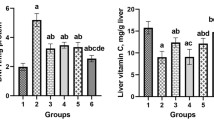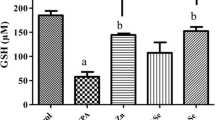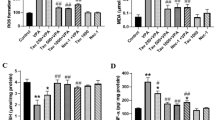Abstract
Valproic acid (VPA) is a anticonvulsant and mood-stabilizing agent used to treat epilepsy in patients of all ages. However, it can cause hepatotoxicity with increased oxidative stress. Melatonin (MEL) is known as antioxidant and antiinflammatory agent. Therefore, the present study designed to investigate the probable protective role of melatonin against VPA-induced liver toxicity. For that purpose, 28 Wistar rats were randomly selected and divided into four groups, namely the Group C (vehicle), VPA (500 mg/kg/day VPA), MEL + VPA (10 mg/kg/day melatonin + 500 mg/kg/day VPA) and MEL (10 mg/kg/day melatonin). The agents were given by oral gavage for 14 days. Blood and liver tissue samples from all the rats were harvested on the 15th day of experiment. Biochemical analyses were conducted on the blood samples. The levels of malondialdehyde (MDA), superoxide dismutase (SOD), alpha glutathione S-transferases (α-GST), nuclear factor-κB (NF-κB), myeloperoxidase (MPO) and changes in gene expression were examined in the liver tissues. Also, liver histopathological analyses were conducted. VPA administration significantly increased the levels of α-GST, MDA, NF-κB and of IL-1β, TNF-α gene expression in the liver compared to Group C. Moreover, vacuolization, hydropic degeneration, inflammatory cell infiltration, and sinusoidal congestion were commonly detected in the VPA-treated group along with the highest apoptotic index (TUNEL staining) values. Melatonin administration was revealed to exhibit powerful protective properties at cellular, inflammatory and oxidative level activities against VPA-induced liver toxicity. Therefore, melatonin administration may be used as an adjuvant therapy against to VPA-induced liver toxicity.




Similar content being viewed by others
References
Perucca E (2002) Pharmacological and therapeutic properties of valproate. CNS Drugs 16(10):695–714
Rosenberg G (2007) The mechanisms of action of valproate in neuropsychiatric disorders: can we see the forest for the trees? Cell Mol Life Sci 64(16):2090–2103
Massa V, Wlodarczyk B, Giavini E, Finnell RH (2006) Myo-inositol enhances teratogenicity of valproic acid in the mouse. Birth Defects Res A 76(3):200–204
Eren M, Saltık-Temizel İN, Koçak N (2004) İlaca bağlı hepatotoksisite. Çocuk Sağlığı ve Hast Derg 47:222–227
Al-Rouby NM, Gawish SM (2013) Histological study on the possible protective effect of nigella sativa oil on experimentally induced hepatotoxicity in albino rats treated with sodium valproate. Global Adv Res J Med Med Sci 2(4):090–099
Asconapé JJ (2018) Pharmacokinetic considerations with the use of antiepileptic drugs in patients with HIV and organ transplants. Curr Neurol Neurosci Rep 18(12):89
Rodriguez C, Mayo JC, Sainz RM, Antolín I, Herrera F, Martín V, Reiter RJ (2004) Regulation of antioxidant enzymes: a significant role for melatonin. J Pineal Res 36(1):1–9
Sokmen BB, Tunali S, Yanardag R (2012) Effects of vitamin U (S-methyl methionine sulphonium chloride) on valproic acid induced liver injury in rats. Food Chem Toxicol 50(10):3562–3566
Nazmy EA, El-Khouly OA, Atef H, Said E (2016) Sulforaphane protects against sodium valproate-induced acute liver injury. Can J Physiol Pharmacol 95(4):420–426
Zawilska JB, Skene DJ, Arendt J (2009) Physiology and pharmacology of melatonin in relation to biological rhythms. Pharmacol Rep 61(3):383–410
İlbey YÖ, Ozbek E, Cekmen M, Somay A, Ozcan L, Otünctemur A et al (2009) Melatonin prevents acetaminophen-induced nephrotoxicity in rats. Int Urol Nephrol 41(3):695–702
Deng WS, Xu Q, Liu YE, Jiang CH, Zhou H, Gu L (2016) Effects of melatonin on liver function and lipid peroxidation in a rat model of hepatic ischemia/reperfusion injury. Exp Ther Med 11(5):1955–1960
Esteban-Zubero E, García-Gil FA, López-Pingarrón L, Alatorre-Jiménez MA, Iñigo-Gil P, Tan DX et al (2016) Potential benefits of melatonin in organ transplantation: a review. J Endocrinol 229(3):R129–R146
Jahovic N, Çevik H, Şehirli AÖ, Yeğen BÇ, Şener G (2003) Melatonin prevents methotrexate-induced hepatorenal oxidative injury in rats. J Pineal Res 34(4):282–287
Şener G, Şehirli AÖ, Şatıroğlu H, Keyer-Uysal M, Yeğen BÇ (2002) Melatonin improves oxidative organ damage in a rat model of thermal injury. Burns 28(5):419–425
Ovali MA, Uzun M (2017) The effects of melatonin administration on KCNQ and KCNH2 gene expressions and QTc interval in pinealectomised rats. Cell Mol Biol 63:45–50
Liang YL, Zhang ZH, Liu XJ, Liu XQ, Tao L, Zhang YF, Wang H, Zhang C, Xu DX (2012) Melatonin protects against apoptosis-inducing factor (AIF)-dependent cell death during acetaminophen-induced acute liver failure. PLoS ONE 7(12):e51911
Lee MS, Lee YJ, Kim BJ, Shin KJ, Chung BC, Baek DJ, Jung BH (2009) The relationship between glucuronide conjugate levels and hepatotoxicity after oral administration of valproic acid. Arch Pharmacal Res 32(7):1029–1035
Loguercio C, De Girolamo V, Cuomo A, Argenzio F, Iannotta C, Disalvo D et al (1998) Determination of plasma α-glutathione-s-transferases in chronic alcohol abusers: relationship with alcohol intake and liver involvement. Alcohol Alcohol 33(4):366–372
Tong V, Teng XW, Chang TK, Abbott FS (2005) Valproic acid I: time course of lipid peroxidation biomarkers, liver toxicity, and valproic acid metabolite levels in rats. Toxicol Sci 86(2):427–435
Shaaban AA, El-Agamy DS (2017) Cytoprotective effects of diallyl trisulfide against valproate-induced hepatotoxicity: new anticonvulsant strategy. Naunyn-Schmiedeberg’s Arch Pharmacol 390(9):919–928
Boyer TD (1989) Special article the glutathione S-transferases: an update. Hepatology 9(3):486–496
Ciba M, Mehmet AK, Karahalil B (2016) Alpha-glutathione-s-transferase can be a biomarker for both drug-related toxicity as well as individual susceptibility. Minerva Psichiatr 57(2):62–71
Hayes JD, Pulford DJ (1995) The glut athione S-transferase supergene family: regulation of GST and the contribution of the lsoenzymes to cancer chemoprotection and drug resistance part I. Crit Rev Biochem Mol Biol 30(6):445–520
Maina I, Rule JA, Wians FH, Poirier M, Grant L, Lee WM, Acute Liver Failure Study Group (2016) α-glutathione S-transferase: a new biomarker for liver injury? J Appl Lab Med. https://doi.org/10.1373/jalm.2016.020412
Tekeli H, Bildik A (2013) Karbon tetraklorür ile oluşturulan karaciğer hasarında glutatyon (GSH) ve glutatyon s-transferaz (GST) aktivitesi üzerine n-asetil sisteinin etkisi. Balıkesir Sağlık Bil Derg 5(2):83–87
Planas-Bohne F, Elizalde M (1992) Activity of glutathione-S-transferase in rat liver and kidneys after administration of lead or cadmium. Arch Toxicol 66(5):365–367
Merle A, Delagrange PH, Renard P, Lesieur D, Cuber JC, Roche M, Pellissier S (2000) Effect of melatonin on motility pattern of small intestine in rats and its inhibition by melatonin receptor antagonist S 22153. J Pineal Res 29(2):116–124
Bulan NÖ, Sarikaya-Unal G, Tunali S, Pirinçci PA, Yanardag R (2015) Melatonin is a potent modulator of antioxidative defense and cellular proliferation against aluminum toxicity in rats. Turk J Biol 39(6):911–924
Reiter RJ, Tan DX, Mayo JC, Sainz RM, Leon J, Czarnocki Z (2003) Melatonin as an antioxidant: biochemical mechanisms and pathophysiological implications in humans. Acta Biochim Polonica-English edition 50(4):1129–1146
Elsharkawy AM, Mann DA (2007) Nuclear factor-κB and the hepatic inflammation-fibrosis-cancer axis. Hepatology 46(2):590–597
Bourdi M, Masubuchi Y, Reilly TP, Amouzadeh HR, Martin JL, George JW, Martin JL, George JW, Shah AG, Pohl LR (2002) Protection against acetaminophen-induced liver injury and lethality by interleukin 10: role of inducible nitric oxide synthase. Hepatology 35(2):289–298
Marcondes-Alves L, Fattori V, Borghi SM, Lourenco-Gonzalez Y, Bussmann AJ, Hirooka EY, Casagrande R, Verri WA Jr, Arakawa NS (2017) Kaurenoic acid extracted from Sphagneticola trilobata reduces acetaminophen-induced hepatotoxicity through inhibition of oxidative stress and pro-inflammatory cytokine production in mice. Nat Prod Res. https://doi.org/10.1080/14786419.2017.1416372
Hintze KJ, Keck AS, Finley JW, Jeffery EH (2003) Induction of hepatic thioredoxin reductase activity by sulforaphane, both in Hepa1c1c7 cells and in male Fisher 344 rats. J Nutr Biochem 14(3):173–179
El-Mowafy AM, Katary MM, Pye C, Ibrahim AS, Elmarakby AA (2016) Novel molecular triggers underlie valproate-induced liver injury and its alleviation by the omega-3 fatty acid DHA: role of inflammation and apoptosis. Heliyon 2(7):e00130
Acknowledgements
This study was supported by Çanakkale Onsekiz Mart University Scientific Research Projects with project number TSA-2017-1108.
Author information
Authors and Affiliations
Corresponding author
Ethics declarations
Conflict of interest
All authors declares that they have no conflict of interest.
Additional information
Publisher's Note
Springer Nature remains neutral with regard to jurisdictional claims in published maps and institutional affiliations.
Rights and permissions
About this article
Cite this article
Oztopuz, O., Turkon, H., Buyuk, B. et al. Melatonin ameliorates sodium valproate-induced hepatotoxicity in rats. Mol Biol Rep 47, 317–325 (2020). https://doi.org/10.1007/s11033-019-05134-6
Received:
Accepted:
Published:
Issue Date:
DOI: https://doi.org/10.1007/s11033-019-05134-6




